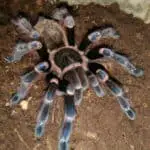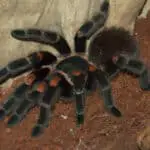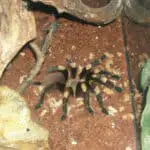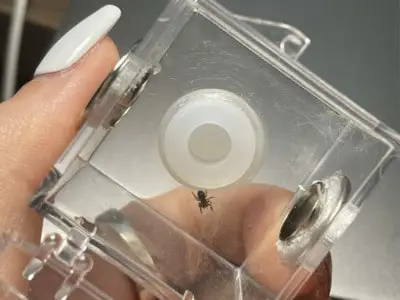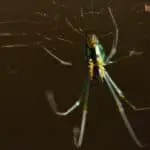If you are a prospective tarantula owner, you must be excited but concerned to get everything right. Regardless of the Tarantula species you go for, there are some accessories that you need to keep your spider comfortable, healthy, and happy. Fortunately, they are relatively easy maintenance, and we will give you details on their primary and secondary needs in this guide.
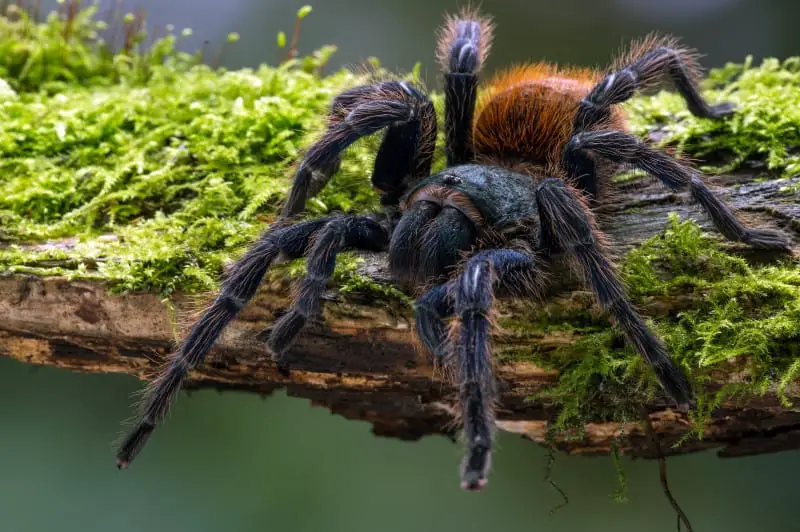
1. Housing
The enclosure is one of the most necessary accessories you need before bringing in your pet. Unlike other creatures, Tarantulas aren’t very social animals; hence, they don’t like frequent handling. Therefore, they spend most of their time in their enclosures and are primarily burrowers who prefer to lay low even when hunting.
You need to create an environment that looks like their home in the wild, either arboreal or terrestrial. Arboreal setups are elongated, while terrestrial homes are wide for more living space. You can go for the Zilla Tropical kit if you have a climbing species and don’t want to waste much space.

It also works when you have a little table room and want an aesthetic structure. Otherwise, you can also go for a short but wide tank like the REPTI ZOO Glass Tank with enough room for your T to play around. There are more designs in the market that you can select based on your preference, but the critical feature is to ensure that the setup is transparent, well-ventilated, and secure.

You would want a glass or acrylic option to help constantly watch over your pet as it grows and monitors all actions. The holes or spaces at the top further ensure proper aeration and a lockable enclosure prevents your spider from sneaking out and keeps out external interference. Additionally, ascertain that the cage is at least 10 gallons, sufficient for most tarantula species.
Read more: Best Tarantula Enclosures
2. Decorations
Primarily, tarantulas are nocturnal who would rather spend the better part of the day hiding away. Besides, they can also be quite antisocial, most don’t like frequent handling, and they get scared easily in the presence of larger creatures. Therefore, in addition to a cozy enclosure, you may also need hides and decorations for them to tuck under when they have to.
Apart from serving as a hiding structure, such objects also act as aesthetic pieces to spruce up your pet’s home. You can also include your favorite items and be as creative as you can. Some owners go for natural objects that you can easily find in the tarantula’s natural home, like these driftwood branches. They look great inside the tank and allow your spider to climb, exercise or hide behind when frightened.

Alternatively, you can also opt for a cork round that you can cut into the preferred length according to your pet and enclosure size. Moreover, you can lift it if you have an arboreal species that loves to climb or lay it down for the terrestrial tarantulas. However, it would help if you were cautious about getting a quality hide that doesn’t rot easily and isn’t a hazard to your pet.

3. Plants
Other accessories that will come in handy are plants. The best way for your tarantula to live and thrive is when living in a home that mimics its natural setup. Pets tend to relax and grow happy when they dwell in an enclosure with plants, and there’s no better way to bring this out than with real or artificial options.
Tarantulas love webbing on the leaves and branches and tend to drink water through the droplets that trickle down. Therefore, it is advisable to purchase non-toxic plants that won’t affect your pet. Besides, you can also include aesthetic options in the enclosure that can also serve as decorations.
There are several options to choose from, and you can play around with the selection. However, the most used options are silk vines and ferns that you can place on the enclosure floor or leave hanging. Many colors are available to help add life to the tank, but it is best to avoid placing many plants at once to avoid cramping the tank, given how small the enclosure already is.

4. Water Dish
The water dish is a must-have accessory, and it is best to always fill it up for your pet to access whenever it needs to drink. Like any other creature, spiders also need a clean and chemical-free water supply. It helps them hydrate and is essential for their physiological processes. You would need a practical water dish for convenience, but it should be non-toxic and easy to clean.
Any chemicals in the item would contaminate the water, and, in turn, affect your spider. Such containers also tend to get dirty after each use; therefore, your best bet should have a smooth and easy layer to clean like this Fluker’s bowl. You can also consider a shallow dish for easy access and prevent your pet from drowning if it falls into it.

Other owners put a clean stone into it for support in case the tarantula climbs inside. Generally, you can tell the right size by looking at your pet’s legs pan; any smaller and shorter dish than your pet would suffice. Therefore, it is best to confirm the dish dimensions when you go shopping for one.
Read more: Best Water Dishes for Tarantula
5. Substrate
Another critical buy is the flooring substrate after purchasing the enclosure, plants, and hides for your pet. Although some keepers would rather leave the enclosure bare, the material you place on the ground matters greatly. Spiders step on forest undergrowth or climb tree barks in the wild; hence, need a similar setup even in captivity. Natural flooring in the enclosure greatly improves moisture retention and keeps the tank comfortable.
Moreover, given that spiders are avid diggers, inches of substrate give them a chance to burrow. Terrestrial species are more skilled diggers and may need more flooring than arboreal types that are better at climbing. There are various substrate types in the market, each perfect for different tarantula species. The most widely used one is coconut fiber because it is soft, easy to burrow, and maintains freshness over a long time.

It is also mold-resistant and doesn’t change whether wet or dry. The material usually comes in a compressed brick form that can soak in water to increase the volume. Another substrate option is peat moss that also helps maintain the enclosure’s humidity levels. Lastly, it is advisable to avoid wood chip substrates since they may contain toxic cedar that can be fatal to your pet.

Read more: Best Tarantula Substrates
6. Thermometer
Your spider needs to live in an environment that closely resembles the one in its natural habitat. Therefore, it is advisable to provide all its needs, including the appropriate temperature and high humidity levels. When you maintain the climatic conditions for your pet, its quality of life improves, as it will grow healthier. However, it is also best to monitor these conditions to guarantee your tarantula’s safety. To keep track of the heat levels in the tank, you need a thermometer.
It will be handy to check that they don’t significantly drop or rise because such conditions can be fatal to your pet. If you notice a decline or increase in the measurements, you can easily adjust the heater for a suitable condition. Cases like these emphasize the need for thermostats for automatic adjustment. The thermostat usually works alongside the appliances to help regulate the heat level emitted.
It guarantees that there are always constant and optimal temperatures preventing your heat pad from getting too hot and “frying” your spider in the process. The thermometer is a great manual method to track the heat levels in the enclosure. Most keepers opt for digital models like this that are easy to read. Lastly, we urge you to select a high-quality make and very accurate to avoid false readings.

7. Hygrometer
You will also need a hygrometer to measure the humidity levels in the enclosure. Spiders thrive under humid conditions; therefore, we advise that you avoid setting up the terrarium close to the window where there is direct sunlight. The intense heat can dehydrate your pet and cause fatalities, explaining why many would rather set the habitat in cooler spots in the house. However, different tarantula species will respond differently to the general humidity levels.
While some Tarantulas would do well at moderate and high humidity, others prefer less humid conditions. Thanks to a hygrometer, you can easily check the moisture levels in the tank and act accordingly to adjust it. Once you know your tarantula species and its needs, it gets easier to undertake any corrective measures.
You can regulate the enclosure’s dampness by misting it using sprayers to increase the humidity to optimum levels, suitable for the health of your buddy. Additionally, you can place a water dish inside the enclosure or wet the substrate instead. Most Ts live better at 60 to 80% humidity levels. Therefore, a hygrometer is a very valuable tool once you embark on the journey to becoming a tarantula parent.
Notably, most quality hygrometers come fused with thermometers enabling you to take the temperature readings simultaneously. For instance, this product comes with amazing features and is also easy to read. It has a suction cap to assist in mounting on the terrarium wall and uses powerful batteries that can last for over a year.
8. Lighting
You may need lights to illuminate the terrarium at night or when the room is dark. However, Spiders are mainly nocturnal creatures that tend to hide away from extreme lighting. Therefore, glaring bulbs may scare them off into their burrows. Unlike reptiles and other vertebrates, the arthropods don’t need UV light waves to synthesize vitamin D.
A little lighting, though, would suffice if you are rearing plants in the enclosure. A full spectrum bulb, for instance, is a wise choice for all the living things in your terrarium. On the other hand, you may opt for a red LED headlamp to monitor your T’s enclosure. Research shows that tarantulas cannot easily notice red wavelengths, allowing you to feed and provide water for them even at night.
You can also use a full spectrum fluorescent bulb to keep the enclosure lit and attractive. The bulb is also safe for the tarantulas and handy for a planted terrarium or animals that don’t require UV lighting. Remember that Ts can survive well in a dim-lit environment and thrive even in a dark habitat.

9. Heater
Sometimes, temperatures can go below the recommended normal, thereby affecting your tarantula. Although these creatures are known to thrive even at room temperature, it is still advisable to keep them at a temperature range of seventy-five to eighty-five degrees. However, this specification can vary from one species to another. Therefore, it is best to understand the optimum heat ideal for your buddy.
There are two ways to go about this if your house experiences sharp temperature drops. First, you can warm the whole house to optimum levels if it’s too cold or put a heater under the enclosure to raise the tank temperatures. There are safe heaters in the market that you can use to warm up your home. There are also space heaters with a thermostat enabling heating that automatically stops when temperatures exceed a certain level.

Similarly, you can buy a terrarium heater for use as a heating pad below the enclosure. If you have a heater that goes in the tank corner, you can give your pet the freedom to pick a suitable spot. It can stay near the heat source when it’s too cold or move away in case of extreme levels. Many keepers go for heating pads or mats for their pet enclosure, and you can set one outside, preferably beneath the setup.

Many also opt for heat bulbs because the mats can overheat and concentrate the heat in a specific spot, while heat lamps distribute it evenly. Heating mats can easily cause dehydration, and, in extreme cases, lead to your pet’s demise. To keep your spider safe, always ensure that all the heating devices have thermostats to manage heat levels even when you aren’t present.
10. Feeder Insects
Food is another important item to buy regardless of the type of pet or species you have. Tarantulas feed on live crickets and mealworms, but they also indulge in insects like grasshoppers and moths when in the wild. Luckily, you can find their meals from pet or retail stores according to your needs. You can buy 2, 3, or 5-week old crickets or small or large mealworms.

The food contains all the necessary proteins and essential nutrients for their growth and development, and they also derive their water from them. If you want a healthy pet, it is advisable to be very keen on their diet, and the best buy is feeder insects, carefully bred for their well-being.
We recommend buying crickets or mealworms for your tarantula to ensure that you are getting a safe meal. Since the manufacturers usually pack them in hundreds, you are certain that they will be cheap and satisfy your pet’s needs. However, it is safe to opt for cricket meals because they are healthier, but you can provide the mealworms as occasional treats since they contain excessive proteins.
Read more: Where to Buy Feeders for Tarantulas
11. Feeder Insect Enclosure
The most advisable meal for a tarantula is live prey because they only eat their kill. In this case, you would need a way to keep the food safe to prevent escaping. Therefore, you will require a separate enclosure to temporarily hold the feeders before serving them to the Ts. There are special containers that can house the insects alive for weeks as you gradually offer them food.
A suitable example of a feeder insect enclosure is Lee’s Kricket Keeper. This container comes in different sizes, small, medium, and large, but you can always choose a suitable option based on your preference. You may need a larger make if you keep many tarantulas because they will require more food. Lee’s small enclosure can house about thirty medium-sized insects for a week or more.

The innovatively designed lid also allows you to feed and view the insects without letting them out of the container. The enclosure has a handle that makes it easy to carry around and has dark cylinders inside for photophobic insects to hide. You can also consider using other enclosures provided that they can keep your pet’s feeders safe and alive.
12. Food for Feeders
Tarantulas need highly nutritious foods containing all the vital elements ideal for great health, and one great option for a mineral-rich diet is feeder insects. However, you can still boost these insects to make them well-balanced meals before you serve them to your pet tarantula, in a process known as gut-loading. Many such meals are available in the market, perfect for your feeders.
For starters, you can consider certain products from Fluker’s, as the Orange Cube Complete Cricket Diet. It is ideal for any feeder insect as it contains water and the necessary vitamins. You may also wish to try this product, which is also an all-in-one diet for feeder insects, and it helps that it is also safe for your pet to eat in surplus cases.

The food comes ready to serve; hence, you won’t require any special preparations before feeding. After opening it for the first time, it is advisable to store it in a refrigerator to keep it fresh. In a single diet, you are certain to get proteins, carbohydrates, minerals, and vitamins, all of good quality. The meal is also easily soluble, giving the feeder insects an easy time digesting.

13. Tweezers
If you are a first-time tarantula keeper, it is natural for you to be scared when handling your pet. It is even scarier when you want to place your hand into the enclosure to pick something up or place it inside. Based on their instincts, tarantulas have a remarkably fast response to external stimuli. It is even more serious because they aren’t very fond of human handling.

Fortunately, a pair of tweezers offer an amicable solution for you. There are wooden options or stainless steel alternatives to select from, depending on your needs. The bamboo feeding tongs are a keepers’ go-to since they cannot damage your pet’s fangs, unlike the steel alternatives. These accessories come in handy when you want to feed your pet but don’t want to get too close and get a bite in the process.

Using them is more convenient and safer than using your hands. Tarantulas are easy to scare, and your hand inside the tank may be too frightening, as most would resort to self-defense by stinging or hair flicking. They are also very helpful when removing any leftover bits but don’t want to take the creature out of the tank.
14. Spray Bottles
Water is a critical component of tarantulas’ lives. They need water to drink, hydrate, and for their normal body functions. Additionally, they need it to help keep their home moist and humid. Primarily, these spider species require around 70% humidity levels in their homes. The wild has such favorable conditions, but you may have to facilitate it when they are in captivity.
We previously discussed one way to help by placing their water dish in the enclosure. It contributes to the overall wetness of the setup, but the best way to create a humid environment is by regularly misting the substrate in the enclosure. For this, you would need a spray bottle since it is convenient and practical.

It helps spray water evenly, and you don’t have to worry about excessively flooding the terrarium. Misting also keeps the spider hydrated, and you can also sprinkle the water on the plants or hides to prevent them from drying. Spraying once in a while will help maintain wetness, perfect for tropical tarantula species, but we recommend getting a non-toxic product that is safe for your pet.
15. Gloves
Safety is paramount, especially when dealing with tarantulas. There are numerous species worldwide, and although some make amazing pets, some can also be quite lethal, especially when improperly handled. If you are too scared to touch your new pet, it is best to avoid contact, but if you must, then you may need a pair of gloves. Most pet tarantulas can sting, causing excruciating pain, but their venom may not be fatal.
The affected area may swell and irritate a bit, just like a bee sting. Note that each will behave differently, and, fortunately, some species can be shy and docile. However, it is best always to put on your gloves while attending to your pet for precaution. With the protective cover, you can confidently pick the tarantula up for grooming, bonding time, or when you want to clean the cage.

The layer will protect you from urticating hairs, which can be detrimental if you are sensitive or allergic to the venom. One great glove that will significantly reduce your phobia is the Venom Steel Gloves. It’s double-layered for ultimate safety against tear, puncture, piercing, and fluid penetration. You may also like Petfusion Multipurpose Gloves, which are comparatively longer and covers your arm up to your elbows to guarantee the best protection.

16. Indoor Insect Trap
Pet tarantulas majorly feed on insects that are available in your nearest pet stores. However, if you want a convenient and cheaper alternative, you can also catch live prey for your spider. Some owners would rather collect feeder insects and feed them to their pets to reduce the overall maintenance cost incurred when buying from retailers.
If you want to implement this alternative, you can buy an indoor set up like an indoor trap or make one from scratch. For a DIY, you can use a bowl full of dish soap and add a little water sprinkled with vinegar at the center. Such a device will assist in obtaining food for your buddy and help you get rid of stubborn bugs at home.

The trapping device is quite attractive and effectively lures insects towards it, immobilizing them in the process, allowing you to collect them and feed them to your pet. The most vulnerable creatures to such traps are houseflies, fruit flies, mosquitoes, gnats, and other edible T delicacies. Fortunately, the gadget is safe for use since it doesn’t have any chemicals; hence would never harm your pet.
17. Tarantula Books
If you are a first-timer trying to learn the ropes of keeping a tarantula, you may find books like the Tarantula Keeper’s Guide quite handy. Experts in the field write such books, and you will never go wrong when taking sage advice. They have the ultimate guide to owning different species.

You can always use them as supplements to your online research because you will find the spider’s origin, breeds, biology, illustrations, and care tips. Besides this, other hard and soft copy options will go a long way to answer your pressing questions. You can purchase them even before bringing in your pet to ensure that you give the best care.
Finally
Tarantulas are relatively easy creatures to care for. Before bringing one in, you may need a sizeable secure enclosure and include other accessories such as hides, plants, and substrates. To ensure that the setup has favorable living conditions, buying a thermometer/ hygrometer, a spray bottle, and lamps for illumination is also necessary. It is also critical to buy feeders or an insect trap, and you can buy a pair of tweezers and gloves for your safety.



